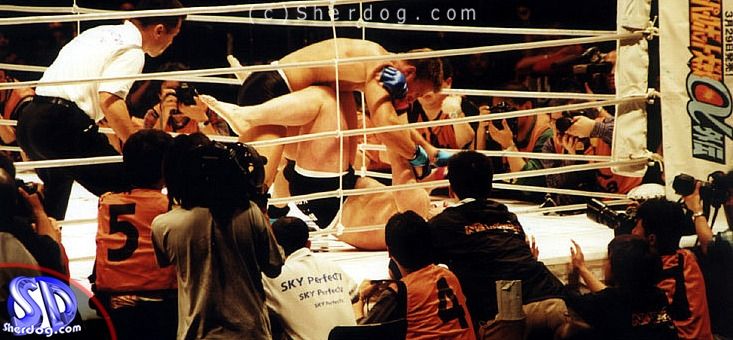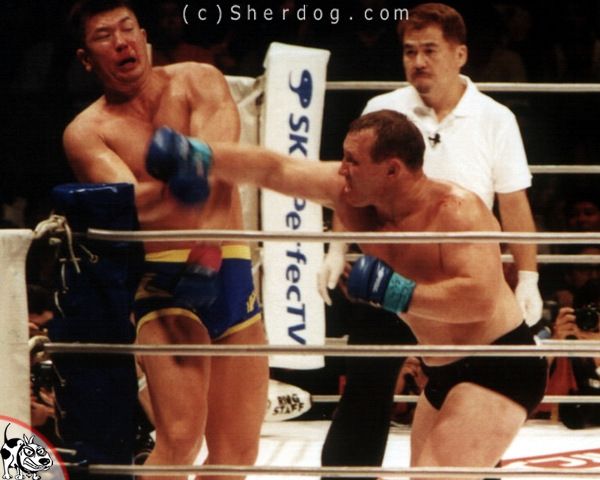Nostalgia vs. Reality: Igor Vovchanchyn
Igor Vovchanchyn is not only an MMA pioneer and legend, but a true hero of the sport. If you met Vovchanchyn in his prime, you would never guess he was a fighter. A calm, polite and genial man, on top of being short and unassuming, one might take him for the restaurateur he would become after his fight career. For as long as he competed in early MMA, or no-holds-barred (NHB) as it was known for much of his era, Vovchanchyn was a man of savage fury. Standing at just 5 feet, 8 inches tall and weighing 225 pounds at his heaviest, the Ukrainian mercilessly battered much larger men, including some who were nearly a foot taller and well over 100 pounds heavier. Frequently, it was Igor standing over the giant crushing him with blow after blow, while the big man lay in the fetal position, hoping the referee would save him from the abuse.
Advertisement
For a while, Vovchanchyn was virtually unbeatable. After two submission losses shortly after his debut in late 1995, one due to blatant cheating by Mikhail Ilyukhin, Vovchanchyn would not lose again that decade, winning 36 fights and drawing one, amassing an amazing 41-2-1 record before he faced Mark Coleman in the finals of the Pride Fighting Championships 2000 Grand Prix. It's also worth recalling that Vovchanchyn was very much in his prime at that time, just 26 years old. Starting from the Coleman fight, however, Vovchanchyn ended his career on a decidedly more mixed record of 14-8. His last fight occurred soon after turning 32, losing a listless decision to Kazuhiro Nakamura, a solid opponent but hardly a legend. What was the main cause of his decline?
First, let us look at Vovchanchyn's skills through a modern lens,
as we did with Pedro Rizzo in
the first installment of this series. Vovchanchyn almost never
threw jabs and instead concentrated on power punches. His favorite
combo was the left hook into overhand right, both punches thrown
with reckless abandon and almost all his strength. The left hook
was decent but often inaccurate, as well as not possessing true
knockout power. The overhand right, however, was a truly monstrous
blow, similar to the casting punch that Emelianenko would use and
perfect even further. It was accurate, fairly fast and had true
one-shot knockout power. Witness for instance his classic knockout
of Francisco
Bueno, who was instantly rendered stiff as a board by an
overhand right, with his head bouncing off the canvas not once but
twice.
This was most of Vovchanchyn’s offense on the feet: left hooks and the moneymaker overhand right. He largely eschewed straight punches, ignoring the jab and rarely even throwing right crosses. He threw kicks to the legs and body at times, but they weren't powerful, and he was leery of doing so for fear of being taken down.
Speaking of the ground, Vovchanchyn doesn't get enough credit for being a striker who developed solid wrestling and ground skills for the time. He gradually developed a degree of defensive wrestling, able to stay upright against weaker attempts, including a sprawl he tried to angle with. He even had some basic ability to get back up. If stuck on the ground, Vovchanchyn was tough and resilient, sustaining some awful positions and heavy punishment but never giving up. His match against Mark Kerr as well as his encounter against 355-pound wrestler Dan Bobish bear this out, as the larger grappler would often rain down knees directly to Igor's trapped head from the north-south position, a legal attack in Pride. Vovchanchyn had very powerful ground-and-pound, whether it was his piston-like knees to the head or his vicious, never-ending punches, like the ones that left Enson Inoue a bloody, battered sack of flesh at the end of the first round. That sounds a lot like Emelianenko, and indeed, Vovchenchyn also made a great living neutralizing grapplers before demolishing them on the feet or from top position.
So, what happened to Vovchanchyn's career? This is where we get to his weaknesses, beginning with the feet. Vovchanchyn's biggest problem wasn't his offensive capabilities, but rather his defense. Even by the standard of his day, his defensive was spotty, and it is poor when viewed through a modern lens. Vovchanchyn circled well at times, but rarely moved his head and lacked defensive instincts. Even worse, he often left himself wide open when throwing his punches, just begging to be countered, and that is not even getting into kicks. As noted, Vovchanchyn's own kicks were limited, but worse than that, he had no idea how to defend against them, whether they were aimed at his head or legs. That's why Mirko Filipovic needed just 89 seconds to knock out Vovchanchyn with a head kick. It's why in a K-1 fight against Ernesto Hoost, the Dutchman absolutely murdered Vovchanchyn with leg kicks, which were never avoided or checked. Even Inoue, mentioned above, who was more of a grappler, caught Inoue with a good straight shot on the feet that opened up a huge cut. Vovchanchyn likely would have lost if he didn't get the takedown in a wild scramble. Like a lot of fighters with poor defense, Vovchanchyn was vulnerable to straight shots.
Offensively, Vovchanchyn was no longer the same terror he had been in the 90s, either. He relied on opponents who had poor defense and gave him big opportunities. Bueno, for instance, was a BJJ practitioner who only been boxing for two years—and not well at that, sticking his chin straight up in the air. Instead of ducking and possibly clinching when Vovchanchyn came forward with his trademark combination, the Brazilian obliged by slowly pulling his head straight back, his chin straight up, beckoning the Ukrainian's right hand to slam him in the face. Take away those opportunities and Vovchanchyn wasn't the same. Look at his decision losses against Tra Telligman and Nakamura. Neither was a great striker, but they were certainly more technically sound than almost anyone the Ukrainian faced earlier in his career. Each also possessed defensive fundamentals. Vovchanchyn couldn't land his big bombs and without effective straight punches or leg kicks, was simply outpointed by opponents who had them, and with far more reach, to boot.
Of course, not all of Vovchanchyn's later losses came on the feet. To his credit, I think his grappling improved continuously during the course of his career, all the way up until the end. It was clearly a big focus, and he got better and better at wrestling and BJJ. Unfortunately, his improvement was still slower than the breakneck pace at which grappling developed in MMA. Against a BJJ legend in Mario Sperry, Vovchanchyn tapped to an arm triangle in just under three minutes. I also find his fight against Heath Herring especially instructive. Herring was a good wrestler for the time, and Vovchanchyn initially had success not only stopping his takedown, but even taking the American down himself. Unfortunately, when Vovchanchyn was on top, Herring continued grappling and eventually swept him, reversing position. Vovchanchyn lost the decision.
While I'm well aware that Vovchanchyn suffered horrible injuries to his hands and knuckles from his early MMA fights, many of which took place without gloves, I doubt it changed much. He was a legend, pioneer, and hero of the sport in the 90s, but the sport had evolved too much by the early 2000s, and Vovchanchyn could be beaten by the new elite on either the feet or the ground. He tried his best to improve, but it just wasn't enough. The same criticism can be levied at almost any 90s fighter except Frank Shamrock, who was years ahead of his time. In parting, let us enjoy one of Vovchanchyn's great triumphs of the 90s, over the 6-foot-8, 350-plus-pound “Polar Bear,” Paul Varelans:
Related Articles


































































































































































































































































